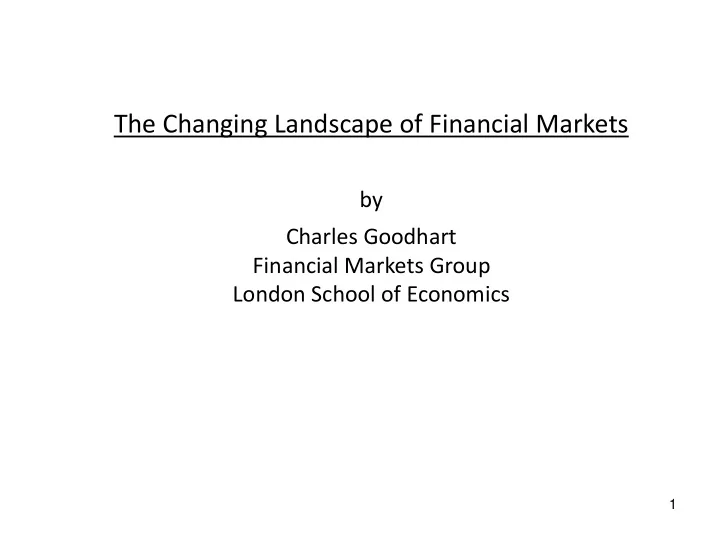

The Changing Landscape of Financial Markets by Charles Goodhart Financial Markets Group London School of Economics 1
I shall briefly review three successive periods, mainly from the viewpoint of a monetary economist:- 1) 1992/93 until 2007 2) 2008 until Now 3) The Future 2
1) 1992/93 → 2007 The best 15 years, from a macro-economic viewpoint in the history of mankind, by far! NICE years. • Steady expansion. • Low inflation. • Declining and low unemployment. • Global inequality declines for the first time since 1800, as poor Asia (China) grows faster than rich EU/North America. 3
NICE years caused by:- Real factors: • Demographic sweet spot. • Globalization; China, E. Europe. • Technology and productivity. Policy: • CBI and Monetary Targets • But two serious failings ; ‘feet of clay’ • Over-optimism on Financial Stability . Minsky and macroeconomic stability breed financial instability. • Worsening inequality within countries. (N.B. Macroeconomics has exhibited exactly the same failings, e.g. the representative agent who never defaults in the common DSGE models.) 4
GFC → Today • Super-expansionary monetary policy. Interest rates down to ELB; QE raises M0 manifold, but bank credit and broad money sluggish. Inflation below target. • Better in USA than EU. Geithner force-feeds US banks with TARP money; with no equivalent pot of money, EU allows banks to raise CARs by deleveraging, largely via declines in cross-border lending. • With fiscal policy constrained by politics, scary debt ratios and Maastricht, monetary policy facing continuing demographic/globalization headwinds. 5
• Did it matter that inflation remained slightly below target? • Main problem has been fall in growth of productivity. Why? But beneficial side effect has been that labour markets have recovered more strongly than product markets. • Revolt of the ‘left - behind’ working class. Immigration is seen by them as the most inimical aspect of globalization. Since left-wing politicians have idealistic views of the commonwealth of mankind, revolt has favoured right-wing nativist populists. 6
The Future • Globalisation is in retreat • Demographic factors are turning adverse. Growth of work force slowing; turning negative in Northern Europe. • Fast rise in over 70s. Ratio of workers to old, dependency ratio, worsening rapidly. Old need care (dementia). • Growth of real income staying low, or even falling. • Equilibrium real rate, therefore, needs to stay low, but ex ante savings may fall relative to ex ante investment. (Politics again) 7
• Also, demographic/globalization changes will increase relative power of labour. • Politics, demography and economics imply revival of inflation, not in next couple of years, but within the next decade. • What happens to inflation target and CBI, once Central Bank governors cease being best friends of Ministers of Finance? 8
Recommend
More recommend